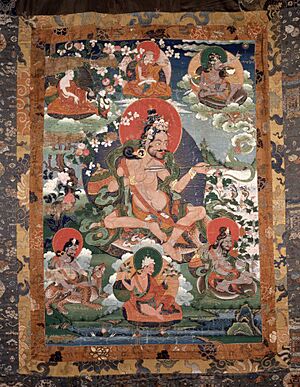Mahamudra facts for kids
Mahamudra (pronounced Mah-hah-MOO-drah) is a special and deep way of practicing meditation in Buddhism. It means "great seal" in Sanskrit, which is an ancient language from India. Think of it like a special stamp that marks something as true or important. This practice helps people understand their minds and the world around them in a very clear way.
Contents
What is Mahamudra?
Mahamudra is a type of advanced meditation. It's about looking closely at your own mind to see how it works. The goal is to find lasting peace and wisdom. It teaches that our minds are naturally clear and bright. Sometimes, however, they get clouded by thoughts and feelings. Through Mahamudra, practitioners learn to see beyond these clouds. They learn to see the true nature of their mind.
Who Practices Mahamudra?
Mahamudra is mainly practiced by three important schools of Tibetan Buddhism:
These schools have passed down the teachings of Mahamudra for hundreds of years. They pass them from teacher to student. Other schools, like the Bön and Nyingma schools, practice a different advanced meditation called Dzogchen.
Important Teachers of Mahamudra
Many wise teachers have helped develop and share the Mahamudra teachings over time. These teachers are known for their deep understanding and for guiding others on this path.
Early Masters
Some of the earliest and most important teachers include:
- Tilopa (around 988–1069): He was a great Indian master. He is considered one of the first to bring these teachings together.
- Maitripa (around 1007–1077): Another key Indian teacher who passed on these profound insights.
- Saraha: An ancient Indian Buddhist master. He is often shown in paintings with other great meditators. His teachings are very old and important.
Tibetan Masters
Later, these teachings came to Tibet and were further developed:
- Milarepa (1052–1135): He was a famous Tibetan yogi and poet. He spent many years meditating in caves. His songs and stories teach about the path to enlightenment.
- Gampopa (1079–1153): He was a student of Milarepa. Gampopa helped to organize the Kagyu school of Buddhism. He wrote important texts that explained Mahamudra in a clear way.
- Lobsang Chökyi Gyaltsen (1570–1662): He was the 4th Panchen Lama. He was a very important teacher in the Gelug school. He wrote a famous text on Mahamudra that is still studied today.
- Wangchuk Dorje (1556–1603): He was the 9th Karmapa, a leader of the Kagyu school. He wrote several influential books about Mahamudra. These books helped many people understand the practice better.
These teachers, and many others, have helped to keep the wisdom of Mahamudra alive. They have ensured it can be practiced by students even today.
Images for kids
-
Gampopa (1079–1153), Kagyu founder
-
Wangchuk Dorje (1556–1603), 9th Karmapa, composed various influential texts on Mahamudra.
See also
 In Spanish: Mahamudra para niños
In Spanish: Mahamudra para niños








